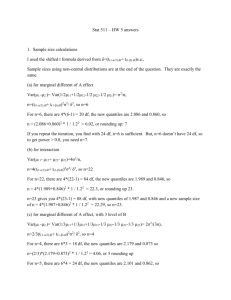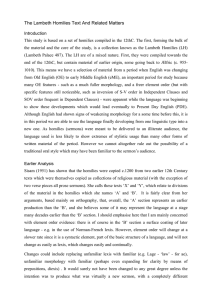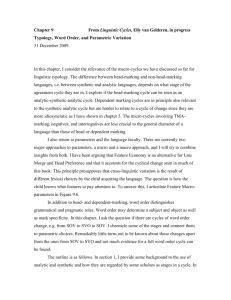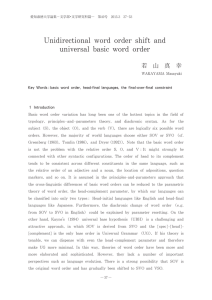big star
advertisement
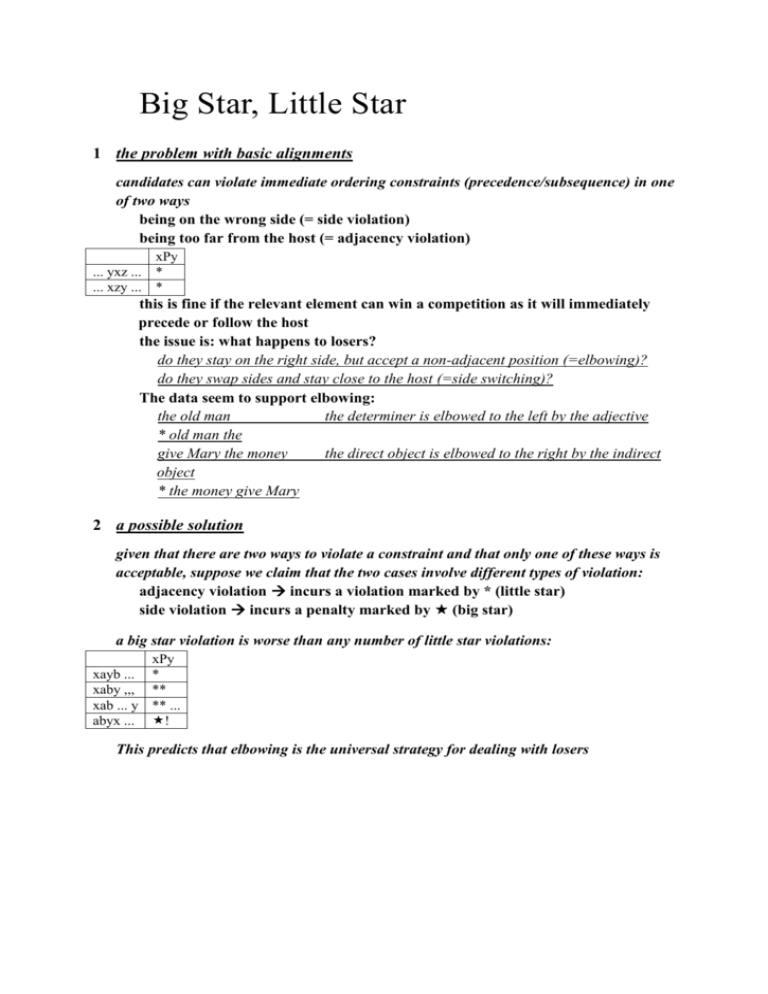
Big Star, Little Star 1 the problem with basic alignments candidates can violate immediate ordering constraints (precedence/subsequence) in one of two ways being on the wrong side (= side violation) being too far from the host (= adjacency violation) xPy ... yxz ... * ... xzy ... * this is fine if the relevant element can win a competition as it will immediately precede or follow the host the issue is: what happens to losers? do they stay on the right side, but accept a non-adjacent position (=elbowing)? do they swap sides and stay close to the host (=side switching)? The data seem to support elbowing: the old man the determiner is elbowed to the left by the adjective * old man the give Mary the money the direct object is elbowed to the right by the indirect object * the money give Mary 2 a possible solution given that there are two ways to violate a constraint and that only one of these ways is acceptable, suppose we claim that the two cases involve different types of violation: adjacency violation incurs a violation marked by * (little star) side violation incurs a penalty marked by (big star) a big star violation is worse than any number of little star violations: xayb ... xaby ,,, xab ... y abyx ... xPy * ** ** ... ! This predicts that elbowing is the universal strategy for dealing with losers 3 Universal word order phenomena of the 6 possible orders of the 3 basic elements of a sentence, all are attested however, some are more frequent than the others SOV = 45% SVO = 42% 96% = SO VSO = 9% VOS = 3% OVS = 1% (some uncertainty on correctness of analysis) OSV = <1% the uncertainty of OVS as a basic word order follows from the fact that the data is not straightforward Hixkaryana allows various word orders and the verb is marked to indicate which argument is subject and object. there is a hierarchy 3rd > 1st > 2nd: if the subject is higher in this hierarchy than the object, then one morpheme is used and if it is lower then another morpheme is used in cases where they are the same, word order distinguishes them in this case the object is the argument in front of the verb and the subject is after 3rd V 3rd (e.g. man eat jaguar) = O V S = the jaguar eats the man on the basis of this, it is argued that OVS is the basic word order and others are derived it also needs to be considered that this statistical analysis forces some round pegs into square holes. there are many languages which have questionable status with regard to this typology Hungarian is not easily categorised as any of these all 6 possibilities are quite frequent (but what has frequency got to do with it) there is no syntactic reason to think that the subject is given any special treatment, as opposed to other arguments (i.e. perhaps Hungarian has no subject Note: thematic role, Case, discourse properties are not the same as subject not all subjects are agents not all subject are nominative not all subjects are topics possible the theoretically most justified assumption is that Hungarian has a V arg basic word order, all others being derived from this this follows from the fact that all pre-verbal positions are associated with a particular interpretation, but post verbal positions are free A number of languages show even greater word order freedom than Hungarian Warlbiri, an Australian language, is known to have almost totally free word order, with the exception that the auxiliary is in second position 4 Possible account in AS of word order patterns Is ‘subject’ basic? a number of approaches argue that the notion subject is derived the subject is just an argument that happens to occupy a certain position hence different arguments can be subjects under different conditions others argue that it is a basic notion of human grammars that different arguments are associated with subject in different constructions is a matter of grammatical process for present purposes we will assume that subject is assigned in the input and hence is subject to possible constraints this might be justified on the observation that the subject is usually an argument, though it is an argument given special treatment other arguments typically have a position different from the subject in SVO languages, the only argument to precede the verb is the subject, all others follow John saw Mary SVO He reacted to the news SVPP I gave the money to Mary SVOPP I said he left SVIP I promised him that I would go SVOIP it seems to me that he is wise SVPPIP so whichever argument is assigned to the subject is given special treatment However, it has to be accepted that the subject is also usually an argument and hence it will also be subject to whatever conditions apply to arguments The analysis sP/Fp subject precedes/follows predicate aP/Fp argument precede/follows predicate (i.e. head initial/head final distinction) Languages where there is no apparent subject we wouldn’t want to say that such languages have no subject in the input inputs should be universal so the lack of the subject must be grammatical the obvious suggestion is that the feature is deleted this can be achieved by the following ranking sPp > sFp > Faith(sub) SVO this is easy to achieve sPp > sFp i.e. subject first language aFp > aPp i.e. arguments in general follow the predicate sPp > aFp i.e. although the subject is an argument, it still comes first Faith(sub) > sPp/sFp the subject feature does not delete 5 Problems OVS is just as easy to produce (just opposite rankings) and so it is not easy to see why SVO is more frequent than OVS SOV and VOS word orders cannot be achieved this is because of harmonic binding a candidate is harmonically bound if there is another candidate which does equally well/badly or better on all constraints sPp OSV SOV * VSO VOS sFp aPp * * * aFp * * it doesn’t matter which order the constraints are in, OSV will always beat SVO and VSO will always beat VOS therefore SOV and VOS can never be grammatical VOS is not a very common language – but it is more common than VSO SOV is the most common language type!!! 6 Possible solutions introduce a sP/Fo constraint this might be the basis of an account for why S precedes O in most of the world’s languages though it is not clear why sPo should be more frequently ranked above sFo this necessitates that we assume that object is a universal feature, assigned in the input but there is little reason to believe that objects are given any special treatment in general objects are DP arguments that are not subjects








